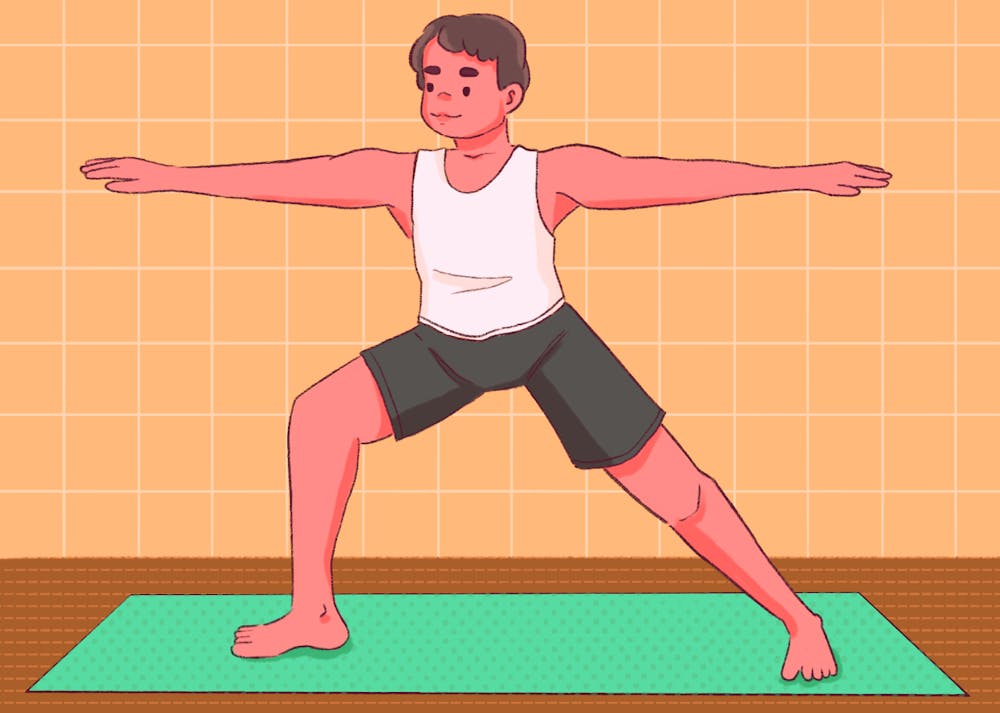A slick film of sweat thickens between my hands and the mat, threatening to buckle my concentration. My legs remain tucked behind elbows, almost hovering parallel to the floor. As the muscle fibers in my arms strain to balance the entire weight of my body, a blissful state of mindfulness bubbles up in my consciousness.
My breath is haggard yet rhythmic. Energy courses through the body; I feel powerful.
Yoga hasn't always been a consistent practice for me. My preferred means of exercise was always running, basketball or soccer.
Like so many other students at the dawn of quarantine, I was depressed. A lack of routine and communal exposure jinxed me into horrible mental ruts. Incapable of self-regulation, feedback loops of rumination, nihilism and YouTube binging reigned supreme in my mind.
Therapy is helpful but there's only so much time and money one can dedicate to self improvement. I finally listened to my mom's simple solution: incorporate yoga as a semi-daily routine.
Its benefits have thoroughly shattered my expectations and melancholy.
So what exactly is yoga?
The word "yoga" originally connoted chariots used by the ancient Hindu Kshatriya warrior caste, although the actual postures and movements we normally associate with yoga likely evolved from pre-Vedic ascetic practices in the fifth or sixth century BCE.
The arrival of the Upanishads — ancient Sanskrit texts that form the basic religious mythos of Hinduism — post-third century BCE catalyzed yoga into a practice for consciousness expansion and meditation, rapidly expanding in popularity over the next few centuries.
While it's typically assumed modern practices were based off these ancient traditions, the poses used today actually stem from the past 150 years or so. Following in the footsteps of famed Hindu monk Swami Vivekananda, gurus introduced modern yoga to the West in the late 19th century.
This consists of asanas (postures) and pranayama (breath work synchronized with the posture movements). The asanas are derived from the Hatha branch of yoga, which historically focused on using physical techniques to achieve spiritual liberation.
The benefits of practicing yoga are striking. Meta-analyses of yoga research have demonstrated consistent health benefits, including reduced short-term depression and anxiety, blood pressure, blood lipid levels, heart rate and stress.
In the brain, meditation is associated with increased gray matter density and gyrification, or the folding of the cortex as it grows. These structural changes can improve the brain's processing speeds and cognitive responses, ultimately resulting in greater positive emotionality and mindfulness at the individual level.
These advantages are invaluable during the era of COVID-19. In the last year, our minds have become so conditioned to polarization and stress — just trying to relax is often difficult.
We tend to fail to recognize the root causes of our suffering, preferring to pacify ourselves with technology when inner spirituality could undoubtedly provide greater relief. In my opinion, yoga's Hindi-Buddhist underpinnings provide the perfect framework for mindfulness and self-improvement in a time when it's so easy to be swept up in a mania from stressful external stimuli.
Despite 2020's obstacles, I've noticed a subtle transformation in how I think and feel in the past few months largely thanks to yoga.
I make sure to spend a few minutes mindfully checking in with my body and brain throughout the day, recognizing any tension and, if there is some, relaxing myself. I reflect more on how my thoughts shape my actions, and how my actions, in turn, shape my relationships with others.
Out in the world, I actively acknowledge the profound beauty of existence, appreciating both nature and people for simply being.
My body has gotten stronger and more flexible, and I can now reliably sink into a meditative state even if my mind feels like a Wall Street day-trading firm.
While I'm not yet at the level I want to be, there has been solid improvement in the months since beginning my practice.
Getting started
To begin your yoga expedition, I recommend attending a class with a friend who practices regularly. You'll be more comfortable trying something new and better able to follow the poses.
Check out YouTube videos for a variety of techniques and levels. I really like Erin from Five Parks Yoga, particularly her Vinyasa flow vids.
Right now I attend Zoom sessions held by an instructor from my mom's gym and I love it. Essentially, do your research and the yoga you need will find you.
When it comes to the actual practice, remember that you are the master of your domain. Don't compare your progress to others and figure out what works for you. Consistency (practicing at least three times a week) is the key to improvement.
The hardest part is getting started. Once you do, I think you'll discover a passion that can only grow.
Reach the reporter at dgrossm2@asu.edu and follow @grossmantweet on Twitter.
Like The State Press on Facebook and follow @statepress on Twitter.
Continue supporting student journalism and donate to The State Press today.




